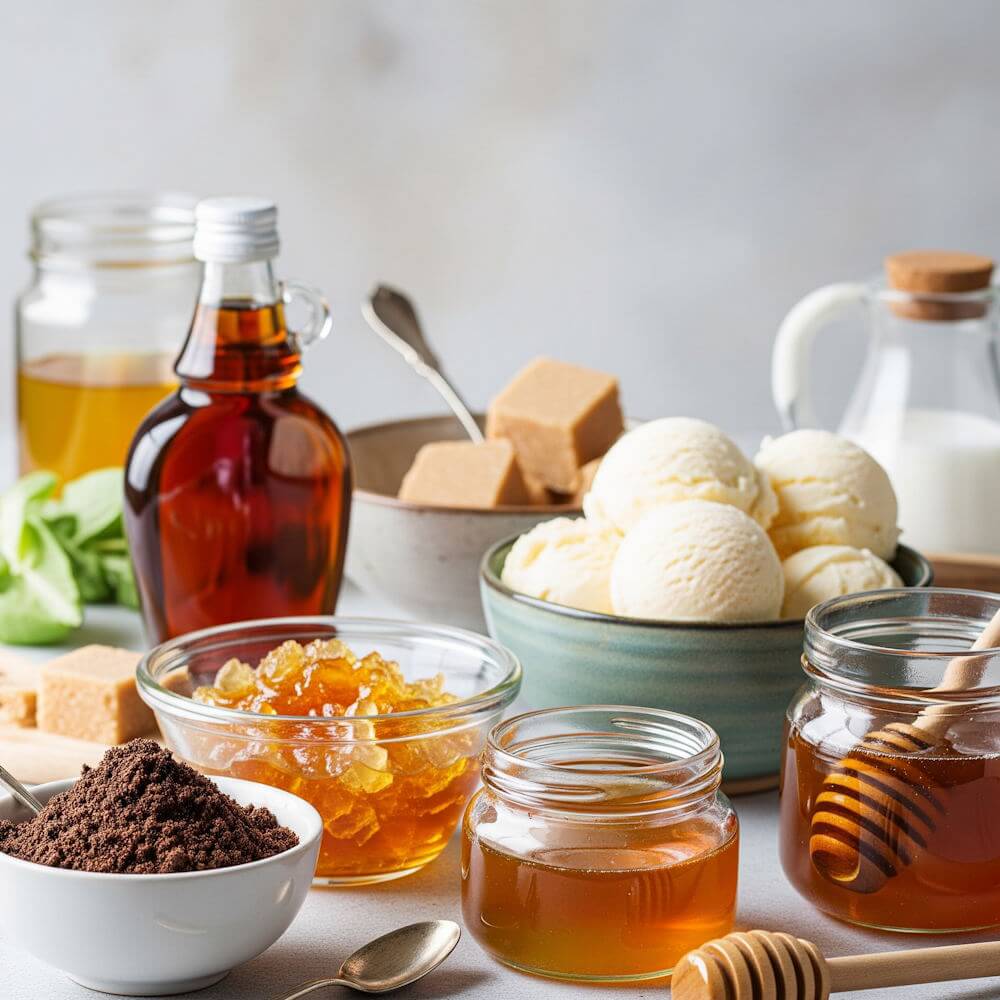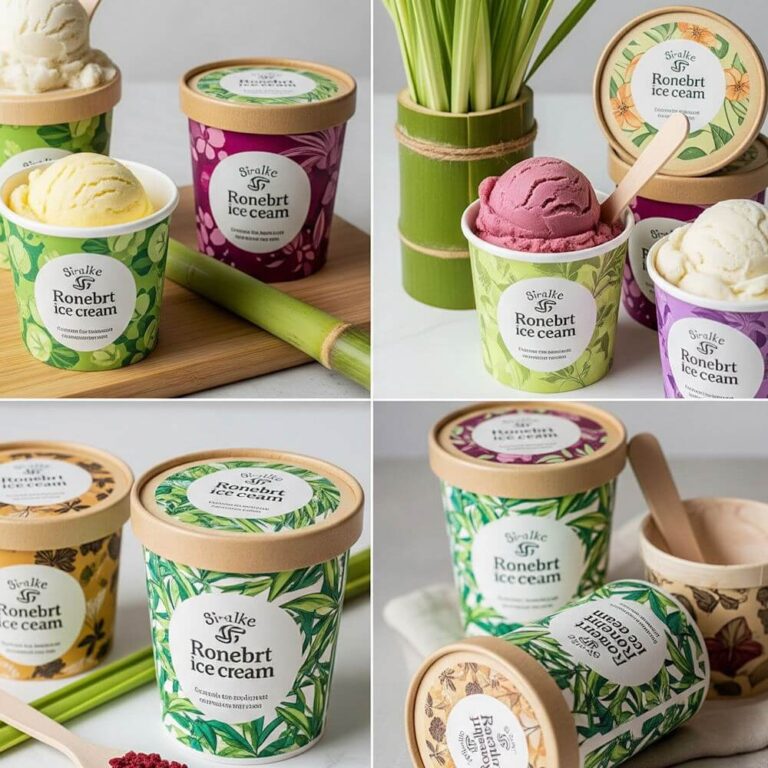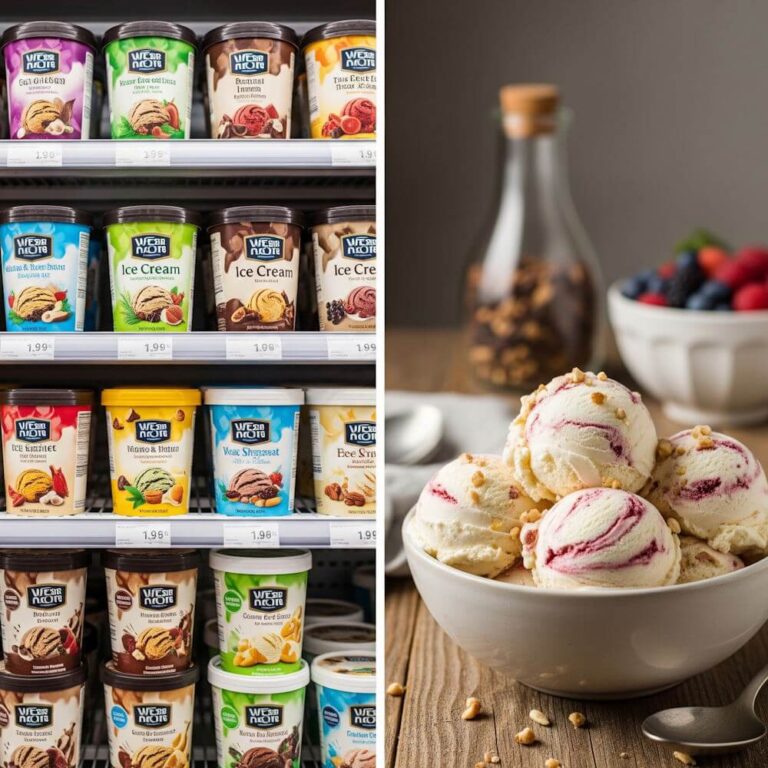Introduction to Natural Sweeteners
Natural sweeteners have gained significant attention in recent years, particularly as health-conscious consumers seek alternatives to refined sugars. These sweeteners are derived from natural sources, such as plants or fruits, and offer a range of flavors that can enhance a variety of culinary creations, including homemade ice cream. The rising popularity of creating ice cream at home has provided an excellent opportunity to explore these healthier options.
The primary advantage of using natural sweeteners lies in their potential to provide a more wholesome sweetness without the negative health effects often associated with refined sugars. Many people are becoming aware of the implications of excessive sugar consumption, including weight gain and increased risk of chronic diseases. In contrast, natural sweeteners can offer a lower glycemic index, meaning they may have a less harmful impact on blood sugar levels. This aspect is particularly important for those managing diabetes, as well as those aiming to maintain balanced energy levels throughout the day.
Moreover, incorporating natural sweeteners in homemade ice cream can elevate the taste profile while allowing for a more personalized flavor experience. Options such as honey, maple syrup, and agave nectar not only provide sweetness but also impart unique flavors that can complement various ingredients. This enables ice cream enthusiasts to experiment with diverse combinations and create healthier versions of their favorite treats.
As consumers strive to lead healthier lifestyles, the integration of natural sweeteners into everyday recipes serves as an effective way to satisfy sweet cravings while being mindful of health. With the growing trend of homemade ice cream, utilizing these alternatives not only enhances the flavor but also supports a more health-conscious approach to dessert-making.
Honey: The Golden Nectar
Honey, often referred to as the golden nectar, stands out as a favored natural sweetener for homemade ice cream. Its unique flavor profile, which can range from floral to earthy, brings a distinct richness that elevates any ice cream recipe. When used in desserts, honey enhances not only sweetness but also adds a complexity that isn’t achievable with regular sugars. This makes it an excellent choice for artisanal ice cream makers who strive for robust and intriguing flavors.
Beyond its delightful taste, honey offers several health benefits. Rich in antioxidants, honey can promote heart health and provide anti-inflammatory properties. It also boasts antimicrobial characteristics, making it a preferable sweetener for those seeking healthier alternatives to refined sugars. Moreover, honey contains trace amounts of vitamins and minerals, contributing to its status as a natural sweetener.
When incorporating honey into ice cream recipes, it is essential to consider its viscosity. Unlike granulated sugar, honey is a liquid sweetener, which can impact the texture of the final product. The natural stickiness of honey not only sweetens but can also help to stabilize the ice cream, preventing ice crystals from forming and ensuring a creamier consistency. A common practice is to mix honey with the cream and other ingredients at the start of the ice cream-making process, allowing for thorough integration. This approach ensures that the honey evenly disseminates throughout the mixture, enhancing both flavor and texture.
For those experimenting with homemade ice cream, honey can be paired successfully with various flavors, including vanilla, chocolate, or fruit. Its adaptability makes it a versatile ingredient that can cater to diverse palates, making every scoop a wholesome and indulgent experience.
Maple Syrup: Nature’s Caramel
Maple syrup stands out as a natural sweetener, offering a rich and unique flavor reminiscent of caramel, making it an excellent choice for homemade ice cream. Derived from the sap of sugar maple trees, this sweetener is processed into a syrup with a distinctive and complex taste profile, which can enhance various ice cream flavors. Its deep, earthy notes blend seamlessly with ingredients such as vanilla, chocolate, and even fruit-based ice creams, providing a delightful contrast that elevates traditional recipes.
In addition to its exquisite taste, maple syrup boasts an array of nutritional benefits. It is a source of essential minerals, including manganese, zinc, and calcium, and contains antioxidants that can help combat free radicals in the body. Unlike some refined sweeteners, maple syrup retains many of the beneficial properties from the sugar maple tree, making it a more wholesome alternative for dessert lovers. However, it is essential to recognize that while maple syrup is more nutritious than granulated sugar, it is still high in calories, and moderation is key during its use in ice cream recipes.
When incorporating maple syrup into homemade ice cream, it is crucial to determine the right amount to achieve the desired sweetness without overshadowing other flavors. A general guideline is to replace about ¾ cup of sugar with ½ cup of maple syrup for each quart of ice cream base; however, this can vary depending on individual taste preferences. Furthermore, since maple syrup adds additional liquid to the mixture, it is advisable to slightly reduce the overall liquid content in the ice cream recipe. This precaution ensures that the desired texture is maintained, preventing the final product from becoming overly thin or icy. The versatility of maple syrup makes it a worthy addition to any ice cream enthusiast’s repertoire.
Agave Nectar: A Low Glycemic Choice
Agave nectar is derived from the sap of the agave plant, primarily found in Mexico, and has gained popularity as a natural sweetener, particularly among those seeking alternatives to table sugar. One of the defining characteristics of agave nectar is its low glycemic index, making it a suitable option for individuals monitoring their blood sugar levels. The glycemic index measures how quickly foods raise blood sugar levels. With a lower glycemic index compared to regular sugar, agave nectar can provide sweetness without causing significant spikes in blood glucose, making it an attractive option for those with diabetes or those aiming for a balanced blood sugar level.
In addition to being a low glycemic sweetener, agave nectar has unique benefits that contribute to its appeal. It is sweeter than table sugar, meaning less is needed to achieve desired sweetness levels. This can help reduce overall caloric intake, as it is more concentrated in flavor. Furthermore, agave nectar has a mild flavor that does not overpower other ingredients, ensuring that the delicate balance of flavors in homemade ice cream remains intact. It is available in various forms, including light and dark varieties, with the latter offering a richer taste that can complement the creamy texture of ice cream.
When incorporating agave nectar into homemade ice cream recipes, it is essential to consider the quantity used. Typically, one can substitute up to two-thirds of the sugar with agave nectar while reducing the liquid content slightly to maintain the desired consistency. This can help enhance the ice cream’s sweetness while preventing it from becoming overly sweet, allowing other flavors, such as vanilla or fruit, to shine through. The careful measurement and incorporation of agave nectar can ensure a harmonious blend, creating a delicious and satisfying dessert option that aligns with various dietary needs.
Coconut Sugar: The Tropical Twist
Coconut sugar, derived from the sap of coconut palm flowers, has gained popularity as a natural sweetener in various culinary applications, including homemade ice cream. Its unique caramel-like flavor offers a delightful twist, enhancing the depth of taste in ice cream recipes. Unlike refined sugars, coconut sugar retains some of the nutrients naturally found in coconuts, such as potassium, magnesium, zinc, and iron. These trace nutrients contribute to its appeal, particularly among health-conscious individuals seeking sweeter alternatives without the empty calories found in refined sugars.
Incorporating coconut sugar into ice cream recipes is quite straightforward. It can be used in a one-to-one ratio as a substitute for white or brown sugar, although it is wise to taste-test the mixture, as the flavor intensity can vary. To achieve optimal results, it is recommended to dissolve the coconut sugar in the ice cream base while heating the mixture gently. This ensures uniform distribution and prevents any graininess in the final product.
Using coconut sugar not only brings a richer flavor to homemade ice cream, but it can also positively impact the texture. The slight moisture content in coconut sugar aids in creating a smoother, creamier consistency by preventing ice crystals from forming. This is particularly important for those homemade ice creams that might otherwise end up icy or hard, making coconut sugar a suitable option for achieving the desired texture.
For individuals looking for a more wholesome sweetening option, coconut sugar presents a compelling alternative. It imparts a unique flavor profile that enhances various ice cream recipes while offering additional nutritional benefits. This makes it a favored choice among those seeking to indulge their sweet tooth without compromising their health-conscious lifestyle.
5. Stevia: The Calorie-Free Wonder
Stevia, derived from the leaves of the Stevia rebaudiana plant, has gained significant popularity as a natural sweetener due to its zero-calorie content. Originating from South America, stevia has been used for centuries by indigenous cultures not only as a sweetener but also for its medicinal properties. This remarkable sweetener is often praised for its ability to provide sweetness without adding calories, making it an attractive option for those looking to reduce sugar intake without sacrificing flavor.
In terms of sweetness potency, stevia is approximately 50 to 300 times sweeter than conventional sugar, which means only a small amount is needed to achieve the desired sweetness. This intense sweetness is attributed to the natural compounds known as steviol glycosides found in the plant. When substituting sugar with stevia in homemade ice cream recipes, it’s essential to start small and gradually adjust according to taste. A mere teaspoon of stevia powder can substitute a cup of sugar, but it’s advisable to consult specific conversion charts to ensure perfect results.
When using stevia in ice cream, it is important to consider its unique taste profile. Some users might notice a distinct aftertaste, which can vary in intensity depending on the brand and processing methods. To help mitigate this, it is recommended to combine stevia with other natural sweeteners like agave or maple syrup, which can enhance the overall flavor profile and enrich the creaminess of the ice cream. Additionally, incorporating stevia into recipes that include flavors like chocolate, vanilla, or fruit will often mask any undesirable aftertaste while still keeping the dish light and enjoyable.
Stevia’s versatility and natural origins make it an excellent choice for those looking to indulge in homemade ice cream without the added calories. Its unique sweetness and the ability to easily blend with other ingredients allow for creativity in crafting delicious, guilt-free treats. When used thoughtfully, stevia can elevate the ice cream experience while maintaining a health-conscious approach.
Date Sugar: The Fiber-Rich Alternative
Date sugar has emerged as a compelling natural sweetener, prized for its unique flavor profile and nutritional benefits, particularly its fiber content. Made from dehydrated dates, this natural sweetener retains much of the fruit’s inherent sweetness while adding a rich, caramel-like taste to various recipes, including homemade ice cream. Unlike refined sugars, date sugar is a whole food that offers additional dietary fiber, which can be beneficial for digestive health.
When incorporating date sugar into ice cream recipes, it is essential to understand how its unique properties can influence both flavor and texture. The natural sweetness of date sugar is more subdued than conventional sweeteners, offering an earthy undertone that transforms the overall taste. To utilize date sugar effectively, it can be blended with other natural sweeteners to achieve a balanced flavor, or used on its own for a distinctively rich ice cream experience.
Additionally, because date sugar does not dissolve as readily as granulated sugars, it may create a slightly coarser texture in your ice cream. To mitigate this, it can be beneficial to combine date sugar with warm liquids during the mixing process, thus allowing it to integrate better into the ice cream base. This technique not only enhances its sweetness but also helps distribute the fiber evenly throughout the mixture, enriching the creaminess of the final product.
In experimenting with date sugar in your ice cream recipes, consider pairing it with flavors such as chocolate, vanilla, or nut-based bases, where its rich profile can shine without overwhelming the palate. Incorporating this fiber-rich alternative not only elevates the taste and textural qualities of your homemade ice cream but also adds substantial nutritional value, making your dessert a wholesome indulgence.
Monk Fruit Sweetener: The New Kid on the Block
Monk fruit sweetener is a relatively new addition to the world of natural sweeteners, gaining popularity for its unique flavor profile and numerous health benefits. Derived from the Monk fruit, native to Southeast Asia, this sweetener is often marketed as a natural alternative to sugar due to its intense sweetness. In fact, monk fruit extract is approximately 150-200 times sweeter than sugar, making it an appealing option for those looking to reduce their sugar intake without sacrificing flavor.
One of the most notable advantages of monk fruit sweetener is that it contains zero calories, making it ideal for various dietary preferences, including low-carb and keto diets. This zero-calorie benefit is attributed to the natural compounds in monk fruit known as mogrosides, which provide sweetness without contributing to calorie intake. As a result, those who are conscious about their weight or blood sugar levels can enjoy the deliciousness of homemade ice cream without the guilt associated with traditional sweeteners.
When incorporating monk fruit sweetener into homemade ice cream, it is essential to consider its potent sweetness. Generally, it is advisable to use monk fruit sweetener in moderation, as a little goes a long way. It can be paired with creamy bases such as coconut milk or almond milk to create a smooth texture while balancing flavors. To enhance the ice cream’s overall taste, consider complementing the monk fruit with other natural flavors, such as vanilla extract or cocoa powder. Since monk fruit can sometimes result in an aftertaste, experimenting with small amounts can help achieve the perfect blend without overpowering your homemade treat.
Tips for Using Natural Sweeteners in Ice Cream
When incorporating natural sweeteners into your homemade ice cream recipes, achieving the right balance of sweetness and texture is crucial. Here are several tips to guide you through the process and enhance your ice cream-making experience.
First and foremost, understanding the different properties of natural sweeteners is essential. Sweeteners such as honey, maple syrup, or agave nectar can vary significantly in sweetness levels compared to granulated sugar. When substituting, a common rule of thumb is to use about two-thirds the amount of liquid sweetener as you would sugar. For example, if your recipe calls for one cup of sugar, consider using around two-thirds of a cup of honey or maple syrup. Keep in mind that these alternatives add moisture, which may slightly alter your ice cream’s texture.
Another important consideration is the flavor profile of the sweetener. For instance, honey may impart a floral taste, while maple syrup brings a rich earthiness to your dessert. Pair your choice of sweeteners with complementary ingredients to create a harmonious flavor experience. For example, using vanilla beans with agave nectar can result in a delightful, well-rounded treat.
Texture also plays a significant role in ice cream quality. Natural sweeteners can affect mouthfeel, leading to a creamier ice cream or a more icy texture. To mitigate this, consider adding stabilizers such as xanthan gum or incorporating a small amount of alcohol, which can prevent ice crystals from forming. Additionally, churning your mixture fully while it freezes can lead to a smoother consistency, enhancing the final outcome of your homemade creation.
Ultimately, experimenting with proportions and combinations is key. Start with small batches to refine your technique before scaling up. By carefully measuring and balancing flavors, you can create delicious homemade ice creams that showcase the unique characteristics of natural sweeteners.
Conclusion: Sweeten Your Ice Cream Naturally
The use of natural sweeteners in homemade ice cream opens a realm of possibilities for both flavor and healthier dessert options. By opting for sweeteners derived from nature, such as honey, maple syrup, or agave nectar, individuals can reduce their intake of refined sugars while enhancing the overall taste experience. These alternatives provide distinctive profiles that can complement various ingredients used in ice cream, allowing for a diverse range of flavors that can be tailored to personal preferences.
Moreover, natural sweeteners often carry additional nutritional benefits, such as vitamins, minerals, and antioxidants, which processed sugars do not offer. By incorporating these ingredients, you not only indulge your sweet tooth but also nourish your body. This approach to making ice cream presents a creative outlet, inviting experimentation with various combinations of sweeteners and flavors. For instance, pairing coconut sugar with coconut milk can result in a rich, tropical treat, whereas using date syrup with nuts can create a deliciously nutty ice cream.
Encouraging readers to explore different natural sweetening options invites them to engage with the creative process of ice cream making. Whether one prefers the floral notes of honey or the caramel undertones of maple syrup, there is a natural sweetener suited for every palate. As you embark on your homemade ice cream endeavors, consider keeping a journal of your experiments—documenting the sweeteners you’ve tried, the flavors you’ve created, and the overall results can lead to delightful discoveries.
Ultimately, making ice cream with natural sweeteners not only yields a healthier dessert but fosters an enjoyable and playful culinary experience. Embrace the journey of crafting unique flavors while also making informed choices that align with your health goals. By sharing your successes and challenges, you can inspire others to join in on the fun of sweetening ice cream naturally.





